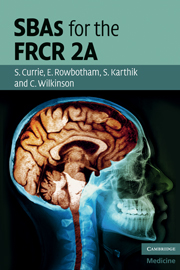Book contents
- Frontmatter
- Contents
- List of contributors
- Preface
- Introduction
- Module 1 Cardiothoracic and vascular
- Questions
- Answers
- Module 2 Musculoskeletal and trauma
- Module 3 Gastro-intestinal
- Module 4 Genito-urinary, adrenal, obstetrics & gynaecology and breast
- Module 5 Paediatric
- Module 6 Central nervous and head & neck
- References
- Index
Answers
Published online by Cambridge University Press: 06 July 2010
- Frontmatter
- Contents
- List of contributors
- Preface
- Introduction
- Module 1 Cardiothoracic and vascular
- Questions
- Answers
- Module 2 Musculoskeletal and trauma
- Module 3 Gastro-intestinal
- Module 4 Genito-urinary, adrenal, obstetrics & gynaecology and breast
- Module 5 Paediatric
- Module 6 Central nervous and head & neck
- References
- Index
Summary
1. e. Scleroderma
Whilst haemoptysis may be a presentation in tuberculosis and Wegener's and bibasal fibrosis maybe seen in all of the above except tuberculosis (where apical fibrosis is the more likely feature), scleroderma is the only condition resulting in a patulous lower oesophageal sphincter, oesophageal shortening and stricture formation.
(Ref: Dahnert p. 863)
2. e. Klebsiella
Klebsiella causes a dense pneumonia with bulging of fissures often associated with an empyema. Pneumococcal pneumonitis can also mimic this.
(Ref: Dahnert p. 504)
3. b. Lingula
This is an example of the silhouette sign where an anteriorly located lingular mass results in loss of the upper left heart border but preservation of the outline of the posterior descending aorta.
(Ref: Grainger & Allison p. 319)
4. b. Intralobar sequestration
Active tuberculosis, consolidation, atypical pulmonary hamartomas and scars may cause false positive results. Uncomplicated sequestration will not demonstrate FDG uptake.
(Ref: Park CM et al. Tumors in the tracheobronchial tree: CT and FDG PET features. Radiographics 2009; 29: 55–71)
5. d. Subpleural
Pulmonary fibrosis associated with asbestos exposure is seen mainly in a subpleural distribution towards the lung bases.
(Ref: Dahnert p. 464)
6. d. Drug toxicity
Post transplant pulmonary complications may develop in up to 40–60% of patients. In the first two weeks or so after transplantation, neutropaenia is the underlying cause for most of these. Angioinvasive aspergillosis presents in the first two to three weeks, usually as multiple ground glass nodules with or without cavitation and peribronchiolar consolidation.
- Type
- Chapter
- Information
- SBAs for the FRCR 2A , pp. 14 - 23Publisher: Cambridge University PressPrint publication year: 2010



